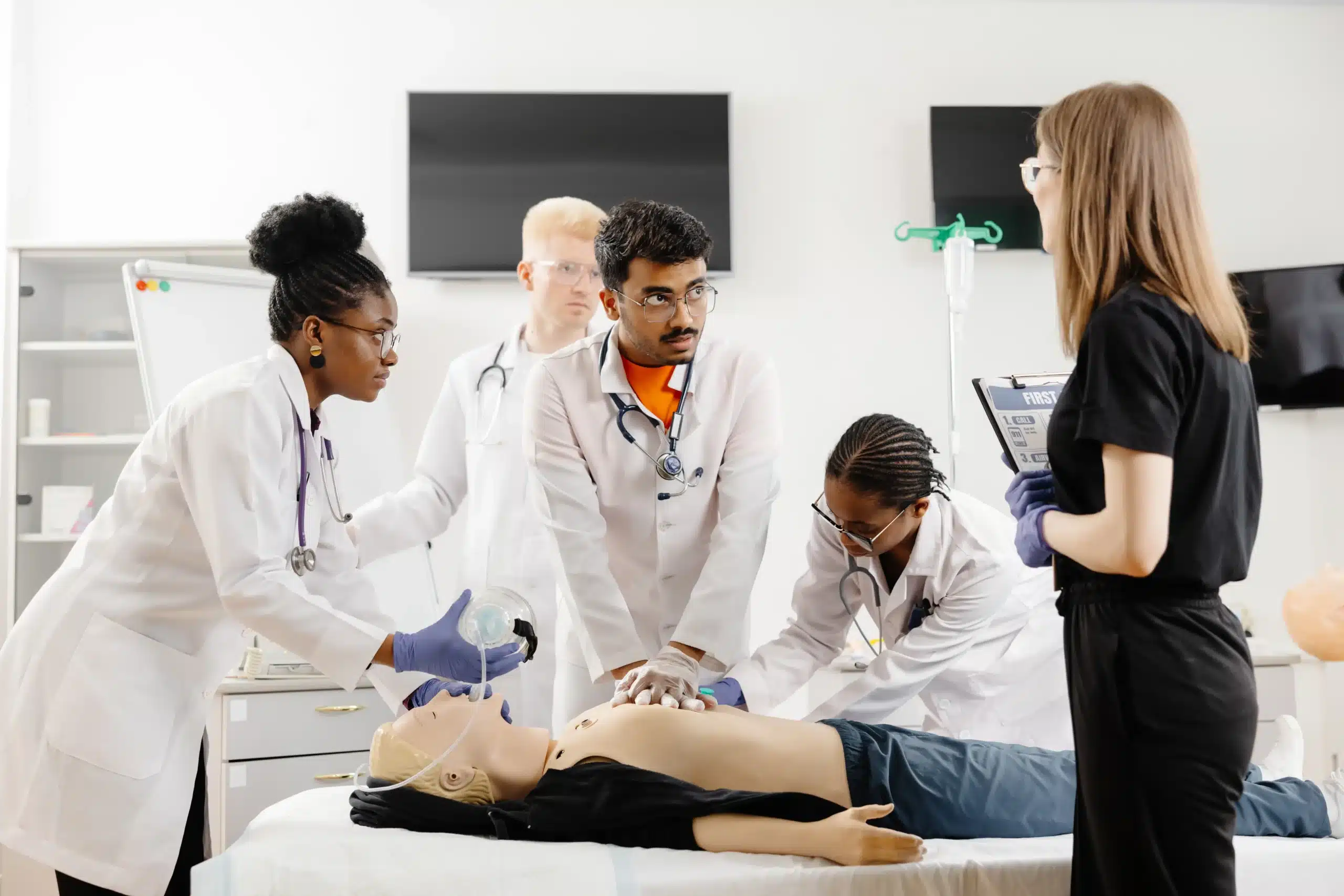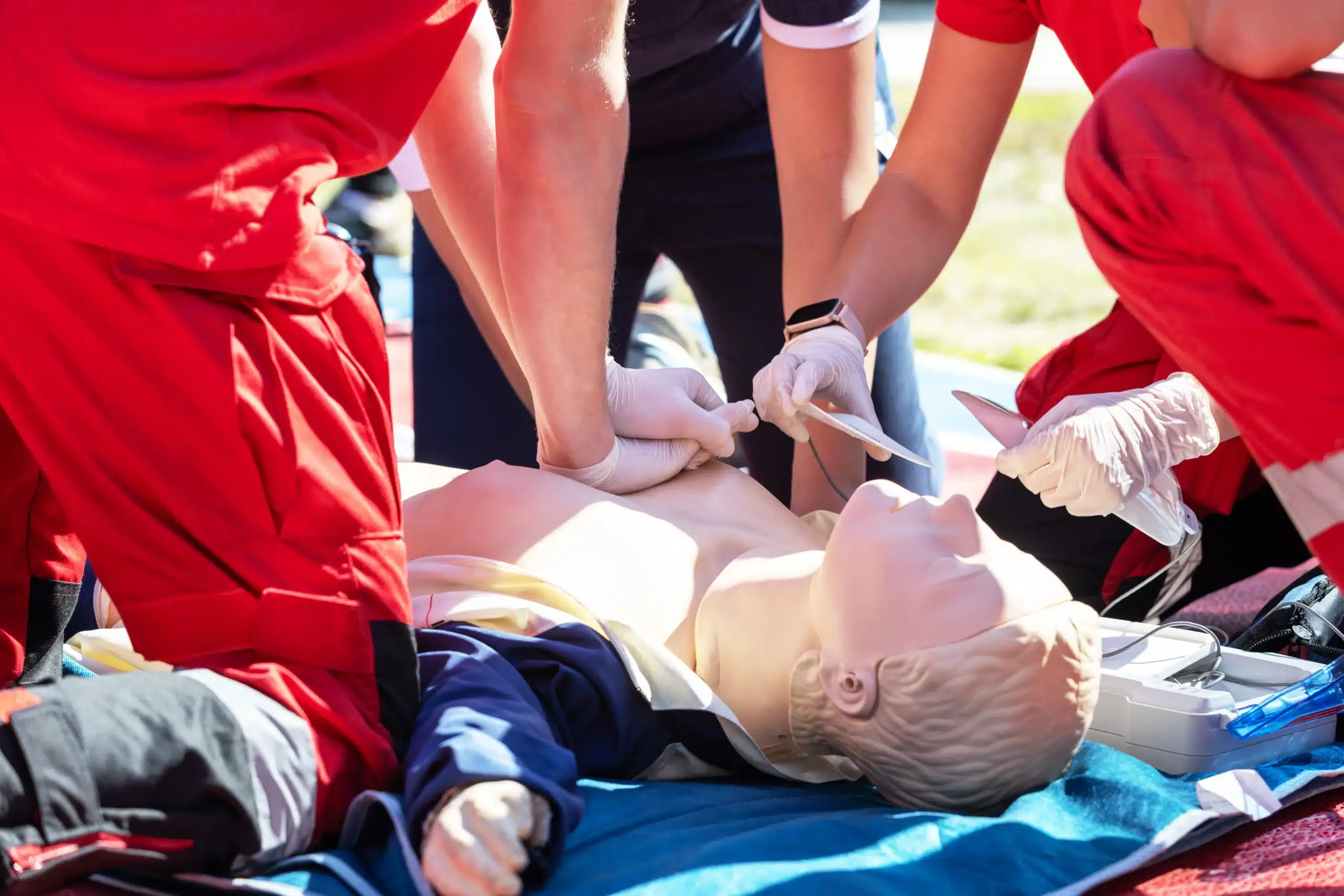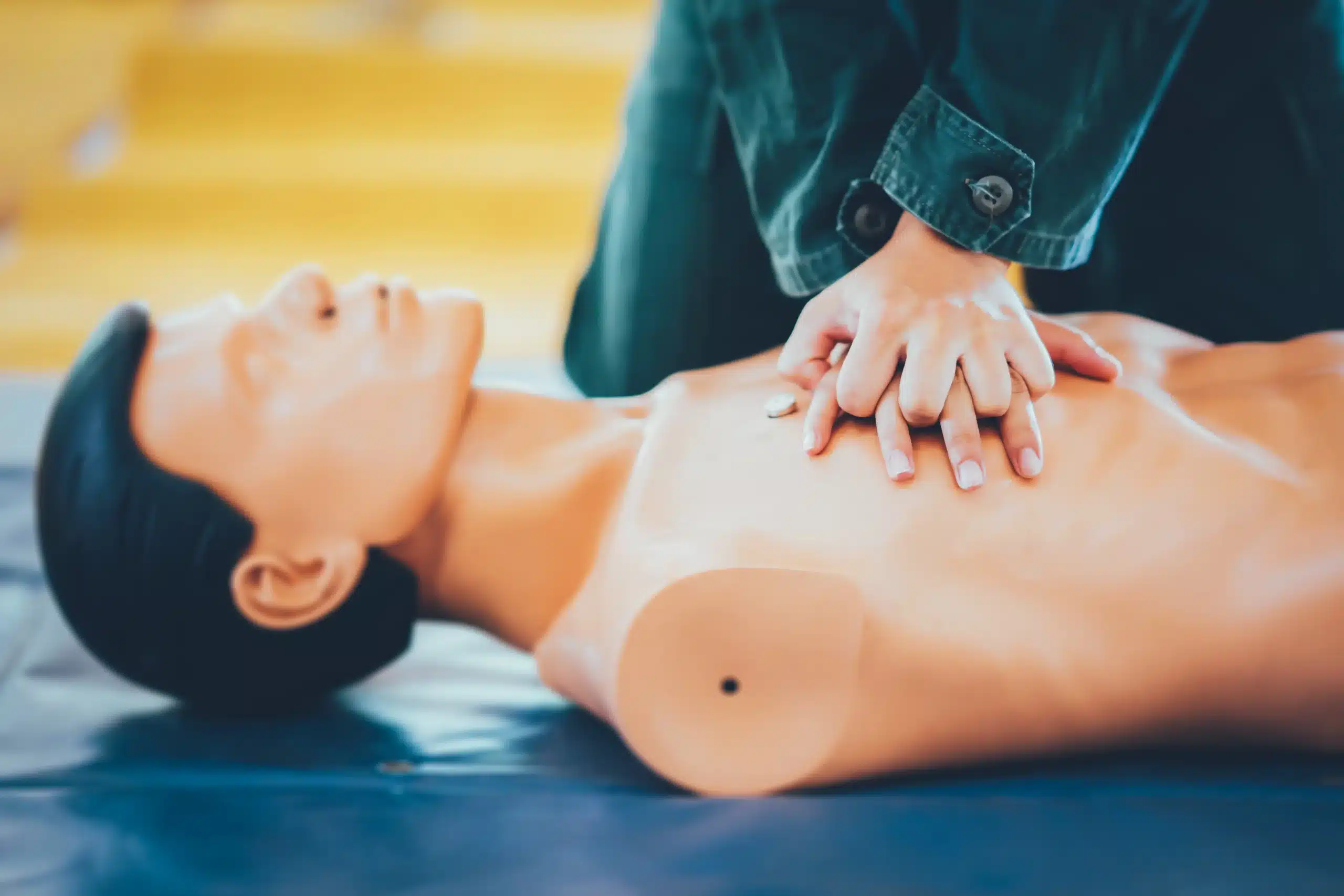Emergencies happen, and knowing how to respond can make all the difference. Heartsaver CPR training empowers you to act quickly and confidently in critical situations, providing essential life-saving skills. This comprehensive guide covers everything you need to know about Heartsaver CPR, from the techniques you’ll learn to the value of this training in various settings. We’ll explore the benefits of CPR certification, address common misconceptions, and guide you through the process of finding the right training program for your needs. Whether you’re required to have CPR certification for your job or simply want to be prepared for anything, this guide will provide valuable insights and actionable steps.
Key Takeaways
- Heartsaver CPR empowers you to act in emergencies: Learn essential skills like CPR for adults, children, and infants, AED use, and choking relief. This training prepares you to respond confidently and effectively in various critical situations.
- Find the right training format for your needs: Choose from in-person classes, online courses, or blended learning options to fit your schedule and learning style. Consider factors like hands-on practice, flexibility, and budget when making your decision.
- Stay certified and practice regularly: Maintain your skills and confidence by renewing your certification every two years and practicing CPR techniques. Consistent practice ensures you’re always prepared to make a difference when it matters most.
What is Heartsaver CPR?
Heartsaver CPR AED is a course designed to prepare you to respond confidently to cardiac emergencies. It teaches you how to perform CPR and operate an automated external defibrillator (AED) safely, effectively, and quickly. The curriculum aligns with the latest science and educational guidelines from the American Heart Association. This means you’re learning the most up-to-date, evidence-based techniques.
Key Skills You’ll Learn
This comprehensive course equips you with essential life-saving skills. You’ll learn how to perform CPR on adults, children, and infants, adapting your technique to each age group. You’ll also gain proficiency in using an AED, a device that can help restore a normal heart rhythm during sudden cardiac arrest. Additionally, the course covers how to help someone who is choking, a skill that can be just as crucial in an emergency. These skills combined give you the tools to handle various critical situations.
Why Heartsaver CPR Training Matters
Heartsaver CPR training offers significant benefits, whether you need it for your job or want to be prepared for any situation. This certification is widely recognized and respected, demonstrating your commitment to safety and preparedness. More importantly, it empowers you to make a real difference in someone’s life. Knowing how to respond effectively in a medical emergency can significantly improve a person’s chances of survival. Consider taking a Heartsaver CPR class to gain valuable skills and confidence. At our Sacramento location, we offer CPR certification courses designed to meet your needs.
Common CPR Myths
Several misconceptions about CPR can prevent people from seeking training. One common myth is that CPR requires extensive medical training. This simply isn’t true. While healthcare professionals use CPR regularly, the core techniques are straightforward and can be learned by anyone. Another myth is that only medical professionals can perform CPR. Again, this is false. Anyone can learn and perform CPR, regardless of their background. In fact, bystander CPR can be critical in the moments before professional help arrives. Don’t let these myths hold you back from gaining these life-saving skills. Contact us today to learn more about our Heartsaver CPR courses.
Who Needs Heartsaver CPR?
This section clarifies who can benefit from Heartsaver CPR training and why it’s valuable for various professions.
Who Should Take This Course?
The Heartsaver CPR AED course suits anyone who wants to learn CPR and how to use an automated external defibrillator (AED). It’s a good choice if you need CPR/AED certification for work, regulatory reasons, or just want to be prepared. You don’t need prior medical experience. The curriculum reflects the latest guidelines from the American Heart Association, covering essential skills like CPR for adults, children, and infants, using an AED, and helping choking victims.
Benefits for Different Professions
Heartsaver CPR training is especially helpful for people in roles where they might encounter emergencies. Think teachers, lifeguards, fitness instructors, childcare providers, and many others. These skills enhance workplace safety and give you the confidence to respond effectively in a crisis. Even outside of these professions, knowing CPR can be invaluable. From fitness professionals and maritime personnel to nannies, babysitters, parents, and grandparents, the Heartsaver CPR/AED/First Aid class prepares individuals to handle emergencies involving adults, children, and infants.
Where to Get Certified: Reputable Heartsaver CPR Providers
Finding the right provider for your Heartsaver CPR training is an important step. Here are a few reputable organizations that offer this certification:
American Heart Association (AHA)
The American Heart Association (AHA) is a leading authority on CPR training and education. Their Heartsaver courses cover essential life-saving techniques, including CPR, AED use, and first aid for adults, children, and infants. AHA certification is widely recognized and respected. You can explore their course offerings on the AHA website.
American Red Cross
The American Red Cross is another well-known and trusted provider of CPR and first aid training. Their Heartsaver courses align with current AHA guidelines and provide comprehensive instruction. The Red Cross offers a variety of course formats, including in-person and online options. Learn more about their programs on the Red Cross website.
National Safety Council (NSC)
The National Safety Council (NSC) offers a range of safety training programs, including Heartsaver CPR and first aid. Their courses emphasize practical skills and real-world scenarios to prepare you for emergencies. The NSC provides training resources for individuals, workplaces, and communities. Explore their Heartsaver CPR training on their website.
Emergency Care & Safety Institute (ECSI)
The Emergency Care & Safety Institute (ECSI) is known for its high-quality CPR and first aid training programs. They offer a variety of courses tailored to different needs, including Heartsaver CPR. ECSI focuses on evidence-based practices and provides comprehensive instruction. Find more information about their CPR and first aid courses on their website.
Safety Training Seminars
Safety Training Seminars, a woman-owned AHA Training Center, offers a comprehensive selection of CPR and first aid courses, including Heartsaver CPR, BLS, ACLS, and PALS. With a focus on affordability and accessibility, they provide the lowest prices in Sacramento County with a low-price guarantee. Serving Sacramento, Roseville, and Rocklin, CA, Safety Training Seminars offers convenient locations and flexible scheduling. Explore their website for more information on their courses and certifications.
What to Expect: Course Content and Structure
This section outlines the key components of a typical Heartsaver CPR course, giving you a clear picture of what you’ll learn. Knowing what to expect can help you feel prepared and confident going into your training.
Adult, Child, and Infant CPR Techniques
Heartsaver CPR courses equip you with the skills to perform CPR on adults, children, and infants. You’ll learn the correct hand placements, compression techniques, and rescue breathing methods for each age group. These techniques are crucial for maintaining blood circulation and oxygen flow during a cardiac emergency. The American Heart Association (AHA) provides detailed guidelines for these procedures.
AED Use
Automated External Defibrillators (AEDs) can restore a normal heart rhythm during sudden cardiac arrest. Your Heartsaver CPR training will cover how to safely and effectively operate an AED. You’ll learn to assess the situation, apply the AED pads, and follow the device’s prompts. This training also covers CPR and how to use an AED on adults, children, and babies.
Choking Relief
Knowing how to respond to a choking incident can prevent a life-threatening situation. Your Heartsaver CPR course will teach you how to recognize the signs of choking and perform appropriate first aid for adults, children, and infants. This includes back blows and abdominal thrusts (Heimlich maneuver) to dislodge the obstruction. Learn these skills to act quickly and confidently in these critical moments.
Recognizing Cardiac Emergencies
Early recognition of a cardiac emergency is vital for effective intervention. Your training will cover how to identify the signs and symptoms of a heart attack, stroke, and cardiac arrest. You’ll learn the importance of calling 911 immediately and initiating CPR or using an AED when necessary. The AHA Heartsaver courses provide comprehensive guidance on recognizing and responding to these emergencies.
First Aid Basics
In addition to CPR and AED training, Heartsaver courses often include basic first aid instruction. You’ll learn how to manage common injuries like cuts, burns, and sprains. This first aid training complements your CPR skills, providing a well-rounded approach to emergency response. Explore these courses to gain practical knowledge for handling a variety of situations, from minor injuries to life-threatening emergencies.
Choosing Your Training: In-Person, Online, or Blended
Deciding on the right CPR training format—in-person, online, or blended—depends on your learning style, schedule, and budget. Let’s break down the pros and cons of each to help you choose the best fit.
In-Person Classes
In-person CPR classes offer that irreplaceable hands-on experience. You’ll learn alongside other students and receive real-time feedback from a certified instructor. This direct interaction is invaluable for mastering essential techniques like chest compressions, rescue breaths, and AED use. Plus, practicing in a group setting can build your confidence and help you feel more prepared for real-life emergencies. If you thrive in a structured, interactive environment, in-person training might be your best bet. Safety Training Seminars offers in-person CPR training right here in Sacramento. We serve Sacramento, Roseville, and Rocklin, CA.
Online Courses
Online CPR courses provide ultimate flexibility. Learn at your own pace, anytime, anywhere—from the comfort of your home or on the go. These courses typically cover the same core material as in-person classes, often using videos and interactive simulations to teach CPR techniques. This format is perfect for those with busy schedules or limited access to in-person training centers. The American Heart Association offers a variety of online options for CPR and first aid certification.
Blended Learning
Blended learning combines the best of both worlds. You’ll complete the theoretical portion of the course online, learning at your own speed, and then attend a shorter, in-person skills session to practice what you’ve learned under the guidance of an instructor. This approach offers a good balance of flexibility and hands-on practice. Many providers, including Life Saver CPR & First Aid Training, offer blended learning CPR courses. This format is also a great option for those seeking EMSA Child Care Health & Safety certification.
Find the Best Format for You
When choosing your training, consider a few key factors. Think about your learning style: do you prefer hands-on instruction or independent study? How much time do you have to dedicate to the course? And, of course, what’s your budget? Safety Training Seminars offers a low price guarantee, ensuring you receive high-quality training at an affordable price. By weighing these factors, you can find a CPR course that aligns with your needs and sets you up for success.
Costs, Value, and Savings: Is Heartsaver CPR Worth It?
Let’s be honest, cost is often a factor when deciding whether to take a class. But when it comes to a skill that could save someone’s life, the real question is, can you afford not to learn CPR? While there’s an upfront investment, the value of Heartsaver CPR training far outweighs the price.
Average Pricing
Heartsaver CPR courses typically range from $75 to $150, depending on your location and the specific training provider. Factors like instructor experience, course materials, and the inclusion of first aid or AED training can all play a role in the final cost. Comparing a few options is always smart before signing up for a class. Check with local community centers, hospitals, or organizations like the American Red Cross for pricing in your area.
Discounts and Promotions
Many training centers offer discounts. Look for price breaks for groups, students, or returning customers. Keep an eye out for special promotions or deals—sometimes workplaces or community organizations will offer discounted rates. Sites like Groupon occasionally feature discounted CPR classes, so it’s worth checking for deals near you.
Safety Training Seminars’ Low-Price Guarantee
Safety Training Seminars is committed to making CPR training accessible. We offer the lowest prices in Sacramento County, backed by our low-price guarantee. We believe cost shouldn’t prevent anyone from learning this essential skill. Serving Sacramento, Roseville, and Rocklin, we offer a variety of American Heart Association (AHA) courses, including BLS, ACLS, PALS, and First Aid.
Long-Term Benefits
Think of CPR certification as an investment, not a one-time expense. The skills you gain can empower you to respond effectively during emergencies. A CPR class might cost around $50 to $150 initially, but the peace of mind and confidence to act in a crisis are invaluable. Plus, many certifications are valid for two years, providing long-term value. Consider the potential consequences of not having CPR training—the inability to help someone in need. When you look at it that way, the cost of a Heartsaver CPR course becomes a small price to pay.
Get Certified and Stay Certified: Maintaining Your Skills
Getting your Heartsaver CPR certification is a fantastic first step, but like any skill, CPR requires upkeep. Knowing how to maintain your certification and keep your skills sharp is crucial for responding effectively in a real emergency.
How Long Does Certification Last?
Your Heartsaver CPR certification is valid for two years. After completing your course, you’ll receive a digital certificate via email, which serves as proof of your training. This two-year timeframe allows ample time to practice your skills while also ensuring you stay up-to-date with the latest guidelines from organizations like the American Heart Association.
Renewal Requirements
When your two-year certification period nears its end, you’ll need to renew. Renewal typically involves retaking the Heartsaver CPR course. This refresher covers any updates to the guidelines and reinforces the essential skills you initially learned. Check with your certifying organization, such as the American Heart Association or the American Red Cross, for specific renewal requirements. At Safety Training Seminars, we offer convenient renewal courses to help you maintain your certification seamlessly.
Practice Regularly
Even with a valid certification, regular practice is key to maintaining proficiency in CPR. Consider practicing key skills like chest compressions and rescue breaths on a CPR manikin. Even mental rehearsal can be beneficial. Visualizing yourself performing CPR and recalling the steps can help solidify the process. Consistent practice builds muscle memory and reinforces the correct techniques, making you better prepared to respond confidently in a real-life emergency.
Build Confidence in Emergencies
Beyond the technical skills, maintaining your CPR certification is about building confidence. Knowing you have the skills and training to handle a cardiac emergency can empower you to act decisively when seconds count. Regular practice and staying current with your certification contribute significantly to this confidence. This assurance benefits you and provides a sense of security to those around you, knowing they have someone trained and ready to assist. At Safety Training Seminars, our instructors focus on building your confidence through hands-on training and realistic scenarios, preparing you to respond effectively under pressure.
Heartsaver CPR vs. Other CPR Courses: What’s the Difference?
BLS and ACLS: Key Differences
Heartsaver CPR and BLS (Basic Life Support) certifications both equip you with life-saving skills, but they cater to different audiences and cover different skill sets. BLS certification is designed for healthcare providers like nurses, paramedics, and other professionals working in hospitals, clinics, and ambulances. It delves into more advanced techniques like two-rescuer CPR, using bag-mask devices for ventilation, and understanding cardiac arrest rhythms. Heartsaver CPR, on the other hand, focuses on essential CPR skills, AED use, and choking relief for anyone—even those without medical backgrounds. Think teachers, lifeguards, or even parents—anyone who wants to be prepared for an emergency. Heartsaver courses often include First Aid training as an optional add-on, making them a well-rounded choice. Both BLS and Heartsaver certifications require ongoing training to stay current with the latest American Heart Association guidelines. You can find more information about our BLS course on our website.
ACLS (Advanced Cardiovascular Life Support) goes a step further than BLS, focusing on advanced life-saving procedures for experienced healthcare professionals. It covers complex algorithms for managing cardiac arrest, stroke, and other acute cardiovascular emergencies. ACLS training typically involves simulations and team-based scenarios to enhance decision-making skills in high-pressure situations. Learn more about our ACLS certification on our site.
Which Course is Right for You?
Choosing the right CPR course depends on your individual needs and career path. If you’re a healthcare professional or aspire to be one, BLS certification is essential. It’s the industry standard for medical settings and provides the foundation for advanced certifications like ACLS. If you work in childcare, you might consider our EMSA Child Care Health & Safety course. If you’re not in healthcare but need or want CPR training for your job, regulatory requirements, or personal peace of mind, Heartsaver CPR is an excellent choice. It equips you with the skills to respond confidently in emergencies. For those seeking recertification, our RQI classes offer a flexible option for maintaining your skills. No matter which course you choose, remember that learning CPR empowers you to make a difference. With our low price guarantee, getting certified is more accessible than ever.
Get Ready: Preparing for Your Heartsaver CPR Course
So, you’ve decided to get your Heartsaver CPR certification—fantastic! Knowing what to expect can help you feel confident and prepared. This section covers the training process, offers tips for a successful learning experience, and outlines the essential materials you’ll need.
What Happens During Training?
Heartsaver CPR courses are designed to be interactive and engaging. You’ll learn how to recognize the signs of a cardiac emergency and respond effectively. The training covers CPR techniques for adults, children, and infants, as well as how to use an automated external defibrillator (AED) and relieve choking. Expect a combination of instructor-led discussions, demonstrations, and hands-on practice sessions. You’ll work with mannequins to practice chest compressions, rescue breaths, and AED use in a safe and controlled environment. The goal is to build your muscle memory and confidence so you can act quickly and efficiently in a real emergency.
Tips for Success
A little preparation goes a long way! Before your Heartsaver CPR class, review any pre-course materials provided by your instructor. This might include a student manual or online resources. Arrive a few minutes early to get settled and familiar with the classroom. During the training, ask questions! Your instructor is there to support you. Active participation, especially during the hands-on practice, is key to mastering the techniques. Don’t be afraid to make mistakes—it’s all part of the learning process. Remember, the ultimate goal is to equip you with the skills and confidence to act in a real emergency. If you’re looking for training options, consider checking out the Heartsaver CPR courses offered by Safety Training Seminars.
Essential Materials
Most Heartsaver CPR courses provide the necessary materials, often included in the course fee. This typically includes a student manual that you can keep as a reference after the training. You’ll receive your official American Heart Association (AHA) certification card via email upon successful completion of the course, valid for two years. Check with your chosen training center, like Safety Training Seminars, to confirm what materials are included and if there’s anything specific you need to bring. Safety Training Seminars offers a low price guarantee, ensuring you’re getting the best value for your training.
Heartsaver CPR in Action: Real-World Impact
Knowing CPR can make a real difference in everyday situations, giving you the confidence to respond effectively during emergencies. From a child choking at a family picnic to a senior experiencing a cardiac event at the grocery store, Heartsaver CPR equips you with the skills to step in and potentially save a life. These skills empower you to act quickly and confidently in moments when seconds count. Consider enrolling in a Heartsaver CPR class to be prepared for these critical situations.
Importance in Daily Life
Think about the people you interact with daily – family, friends, neighbors, and even strangers. Having Heartsaver CPR training means you’re prepared to assist anyone if a medical emergency arises, whether at home, work, or out in the community. This preparedness not only benefits those around you but also brings a sense of personal empowerment.
Workplace Safety
Many workplaces require or encourage CPR certification, especially jobs involving children, fitness instruction, or healthcare. Heartsaver CPR training creates a safer environment for everyone, from fitness instructors and maritime personnel to nannies. Having trained individuals on-site can significantly improve outcomes in emergency situations. This proactive approach to safety demonstrates a commitment to employee well-being and can be a valuable asset when attracting and retaining talent. CPR-trained employees contribute to a more secure and resilient work environment.
Community Impact
Widespread CPR training strengthens communities by creating a network of people ready to respond to emergencies. AHA-certified courses, like those offered by Safety Training Seminars, provide standardized training recognized by employers, ensuring a consistent level of knowledge and skill. This shared knowledge fosters a culture of preparedness and mutual support. By investing in CPR training, communities invest in their collective safety and resilience. Accessible and affordable training options ensure that more people can participate, building a safer and more supportive community for everyone.
Related Articles
- Debunking 10 CPR Myths You Need to Know – Sacramento CPR
- CPR Classes in Sacramento: The Complete Guide – Sacramento CPR Classes
- Online CPR Classes in Sacramento: Your Complete Guide – Sacramento CPR Classes
- ACLS HeartCode Sacramento: Your Certification Guide – Sacramento CPR Classes
- CPR & First Aid in Sacramento: Your Guide – Sacramento CPR Classes
Frequently Asked Questions
What’s the difference between Heartsaver CPR and BLS?
Heartsaver CPR focuses on essential life-saving skills for anyone, while BLS (Basic Life Support) is geared towards healthcare providers and includes more advanced techniques. Heartsaver often includes First Aid and AED training, making it a comprehensive option for those outside the medical field. BLS is typically required for healthcare professionals and builds a foundation for more specialized certifications like ACLS.
How long is a Heartsaver CPR certification valid?
Heartsaver CPR certifications are typically valid for two years. You’ll receive a digital certificate after completing the course, and renewal involves retaking the course to refresh your skills and learn any updated guidelines.
What if I’m nervous about performing CPR in a real emergency?
It’s completely normal to feel apprehensive about using CPR in a real-life situation. That’s why hands-on practice during the course is so important. The more you practice, the more confident you’ll become. Regularly reviewing the material and visualizing yourself performing the steps can also help build your confidence.
Are online Heartsaver CPR courses as effective as in-person classes?
Online courses offer flexibility, but in-person classes provide hands-on practice and direct feedback from an instructor. Blended learning, which combines online learning with an in-person skills session, can be a great compromise. Consider your learning style and preferences when choosing the best format for you.
How can I find affordable Heartsaver CPR training near me?
Check with local community centers, hospitals, or organizations like the American Red Cross and American Heart Association for course offerings and pricing. Also, look for discounts or promotions that training centers may offer. Safety Training Seminars offers a low-price guarantee for courses in Sacramento County.








